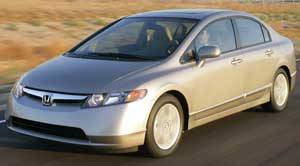To more finely balance the totally revised 2006 Civic model due out this fall between improved fuel economy and more performance, Honda has developed a new 1.8-litre inline-four engine with variable valve timing.
At its most powerful, by the way, the new engine will put out 140-hp and 128 lb-ft of torque.
According to Richard Jacobs of Honda Canada, the new engine uses an "intelligent i-VTEC system that switches the valve timing from maximum efficiency during startup and acceleration to achieve powerful performance with excellent torque output, then delays intake valve closure timing during cruising and other low-load conditions for enhanced fuel economy."
Jacobs says that use of the valve timing control system results in off-the-line acceleration performance at low rpm "equivalent to that of a 2-litre engine, with fuel economy that is up to six per cent better (according to Honda's own tests) than the current 1.7-litre Civic engine, making it one of the world's most efficient 1.8-litre engine designs."
During cruising, claims Jacobs, the new engine achieves "particularly high fuel economy," on a par with that of a 1.5-litre engine.
With the new i-VTEC engine, intake valve closure timing is delayed to control the intake volume of the air-fuel mixture, allowing the throttle valve to remain wide open even under low-load conditions, for a major reduction in pumping losses of up to 16 per cent.
By way of comparison, says Jacobs, the throttle valve of a conventional engine under low-load conditions is normally partly closed to control the intake volume of the air-fuel mixture. Pumping losses are thereby incurred due to increased intake resistance, "a significant factor that leads to reduced engine efficiency, while the new i-VTEC engine minimizes this pumping loss effect to increase efficiency."
Jacobs explains that, "combined with comprehensive friction-reducing measures, the delayed intake valve closing results in a significant increase in fuel efficiency for the engine itself." A drive-by-wire (DBW) throttle control system provides a "highly precise control over the throttle valve while the valve timing is being changed over, ensuring smooth driving performance that leaves the driver unaware of any torque fluctuations."
Other innovations in the new 1.8-litre engine include a variable-length intake manifold that "delivers optimum inertia effect to further improve intake efficiency for powerful torque delivery at rpm ranges typical in normal driving."
Also, oil jets reduce piston operating temperatures, which help suppress the possibility for engine knock in an engine with a 10.5:1 compression ratio.
Overall, the new engine "delivers enhanced emissions performance by employing a two-bed catalytic converter positioned immediately after the manifold and a high-precision air-fuel ratio control to achieve Tier 2 Bin 5 emission levels."
The new engine is both lighter, shorter and quieter than the current Civic 1.7-litre engine, Jacobs points out, and the lower block construction results in a "highly rigid design."
Developments that help make the engine more compact and lightweight include aluminum rocker arms, high-strength cracked connecting rods, and a narrow, silent cam chain.
The Honda Civic has been the top-selling passenger car in Canada for the past eight years (Ford usually sells more pickups, and Dodge often sells more minivans), and Honda Canada would dearly love to see that status maintained.
photo:Honda Canada
At its most powerful, by the way, the new engine will put out 140-hp and 128 lb-ft of torque.
 |
| (photo: Honda Canada) |
Jacobs says that use of the valve timing control system results in off-the-line acceleration performance at low rpm "equivalent to that of a 2-litre engine, with fuel economy that is up to six per cent better (according to Honda's own tests) than the current 1.7-litre Civic engine, making it one of the world's most efficient 1.8-litre engine designs."
During cruising, claims Jacobs, the new engine achieves "particularly high fuel economy," on a par with that of a 1.5-litre engine.
With the new i-VTEC engine, intake valve closure timing is delayed to control the intake volume of the air-fuel mixture, allowing the throttle valve to remain wide open even under low-load conditions, for a major reduction in pumping losses of up to 16 per cent.
By way of comparison, says Jacobs, the throttle valve of a conventional engine under low-load conditions is normally partly closed to control the intake volume of the air-fuel mixture. Pumping losses are thereby incurred due to increased intake resistance, "a significant factor that leads to reduced engine efficiency, while the new i-VTEC engine minimizes this pumping loss effect to increase efficiency."
Jacobs explains that, "combined with comprehensive friction-reducing measures, the delayed intake valve closing results in a significant increase in fuel efficiency for the engine itself." A drive-by-wire (DBW) throttle control system provides a "highly precise control over the throttle valve while the valve timing is being changed over, ensuring smooth driving performance that leaves the driver unaware of any torque fluctuations."
 |
| (photo: Honda Canada) |
Also, oil jets reduce piston operating temperatures, which help suppress the possibility for engine knock in an engine with a 10.5:1 compression ratio.
Overall, the new engine "delivers enhanced emissions performance by employing a two-bed catalytic converter positioned immediately after the manifold and a high-precision air-fuel ratio control to achieve Tier 2 Bin 5 emission levels."
The new engine is both lighter, shorter and quieter than the current Civic 1.7-litre engine, Jacobs points out, and the lower block construction results in a "highly rigid design."
Developments that help make the engine more compact and lightweight include aluminum rocker arms, high-strength cracked connecting rods, and a narrow, silent cam chain.
The Honda Civic has been the top-selling passenger car in Canada for the past eight years (Ford usually sells more pickups, and Dodge often sells more minivans), and Honda Canada would dearly love to see that status maintained.
photo:Honda Canada




Article Gallery


